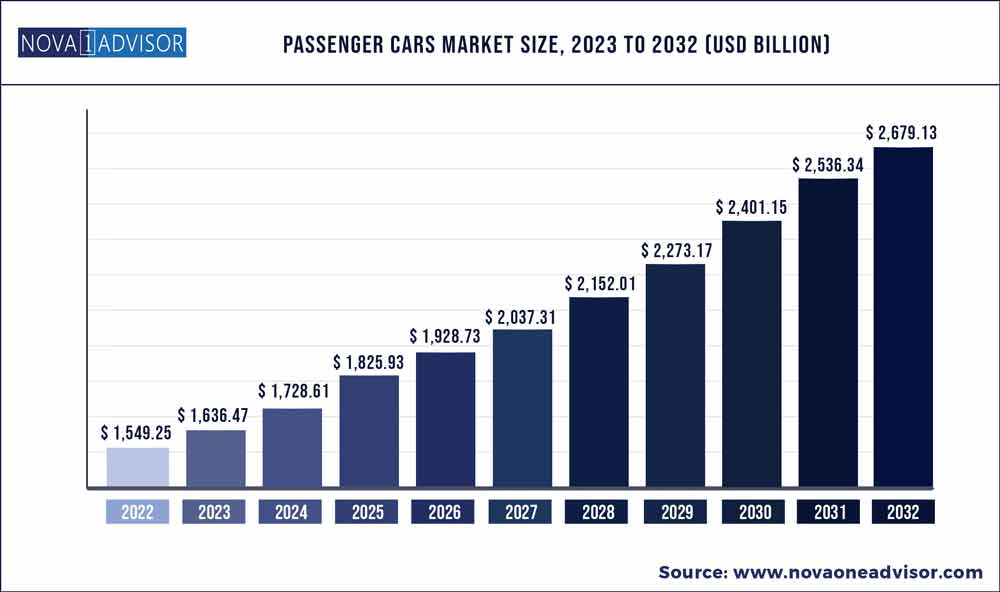The global passenger cars market size was exhibited at USD 1,549.25 billion in 2022 and is projected to hit around USD 2,679.13 billion by 2032, growing at a CAGR of 5.63% during the forecast period 2023 to 2032.

Key Pointers:
- North America accounted for the largest revenue share in 2022.
- By fuel type, the electric segment is predicted to dominate the market from 2023 to 2032.
- By vehicle type, the compact-SUV segment is expected to dominate the market from 2023 to 2032.
Passenger Cars Market Report Scope
|
Report Coverage
|
Details
|
|
Market Size in 2023
|
USD 1,636.47 Billion
|
|
Market Size by 2032
|
USD 2,679.13 Billion
|
|
Growth Rate From 2023 to 2032
|
CAGR of 5.63%
|
|
Base Year
|
2022
|
|
Forecast Period
|
2023 to 2032
|
|
Segments Covered
|
By Fuel Type and By Vehicle Type
|
|
Market Analysis (Terms Used)
|
Value (US$ Million/Billion) or (Volume/Units)
|
|
Regional Scope
|
North America; Europe; Asia Pacific; Central and South America; the Middle East and Africa
|
|
Key Companies Profiled
|
General Motors, Volkswagen, Toyota, Hyundai, Ford, Nissan, Peugeot S.A., Tesla, Honda, Mercedes, Audi, TATA Motors, Kia Motors, Renault, Suzuki Motor Corporation and Others.
|
Passenger cars are the most common means of transportation in developed countries. In recent years there been tremendous adoption in advanced technologies such as advanced driver assistance system (ADAS). Adoption of electric vehicle is fuelling the demand for passenger cars. Due to the increase in per capita income, the number of passenger cars in developing countries is also increasing. The passenger car market of a country depends to a large extent on its current economic conditions, which is why the industry dropped during the recession in the United States and Europe. Many passenger car manufacturers, including General Motors, Ford and Chrysler, have had to seek large loans to continue production in a sluggish economy. Rising raw material prices are one of the biggest concerns in the passenger car market. The prices of steel and plastics have soared to high levels recently, leading to an increase in the price of passenger cars to consumers. The passenger car market depends largely on research and development, and its products need to meet real-time customer needs to remain competitive.
Geographically, the Passenger Cars market is segmented into North America, Europe, Asia Pacific, and the rest of the world. Asia Pacific holds the maximum share in the global market and is expected to propel further owing to the rapid adoption of advanced technologies by the automotive industry. Developing and developed countries such as India, China, Japan and South Korea are the largest contributors in the world’s automotive market. In addition, with the rapid urbanization of cities in countries such as India, China, and ASEAN countries, the demand and sales of passenger cars have been increasing. Increasing disposable income of consumers is boosting the demand for passenger cars. The European region recorded the second-largest share. Rising adoption of electric vehicle charging infrastructure is helping to maintain second-largest position in the market. Presence of major key players in this region and rising adoption of advanced technologies is boosting the passenger car market in this region. North America to show a decent growth in the passenger car market.
Some of the prominent players in the Passenger Cars Market include:
- General Motors
- Volkswagen
- Toyota
- Hyundai
- Ford
- Nissan
- Peugeot S.A.
- Tesla
- Honda
- Mercedes
- Audi
- TATA Motors
- Kia Motors
- Renault
- Suzuki Motor Corporation
- Segments Covered in the Report
This report forecasts revenue growth at global, regional, and country levels and provides an analysis of the latest industry trends in each of the sub-segments from 2018 to 2032. For this study, Nova one advisor, Inc. has segmented the global Passenger Cars market.
By Fuel Type
- Petrol
- Diesel
- Hybrid
- Electric
By Vehicle Type
- Hatchback
- Sedan
- Compact-SUV
- SUV
By Region
- North America
- Europe
- Asia-Pacific
- Latin America
- Middle East & Africa (MEA)

